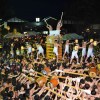Japan is, by almost any criteria, an extremely safe country. You can wander most back alleys of Tokyo in the dead of night without any sense of danger, and calmly carry huge amounts of cash secure in the knowledge that you’re about as likely to come across a mugger in downtown as a man riding a horse.
While this bubble of safety is definitely a plus when you’re inside it, the flipside is that Japanese travelers, unaccustomed to street crime, violent or otherwise, tend to be extremely risk averse when going abroad. Driving this point home is the East Africa edition of a popular series of Japanese guidebooks, which is filled with warnings of danger that seem more like something out of a pulp action novel than a travel reference.
Publisher Diamond has a wide variety of travel guidebooks in its Chikyu no Arukikata series, most of which include detailed outlines for walking tours.
Chikyu no Arukikata’s writers took a different tack with their East Africa edition. More so than its descriptions of historic and cultural sites, the book’s nonstop parade of cautionary tales is what really makes an impression on the reader.
The book covers Uganda, Ethiopia, Kenya, and Tanzania. Recently, one of the writers for our Japanese-language sister site read through the chapters on Kenya, and shared some of the more chilling bits of advice it contains, such as this:
We don’t want our readers to run into any trouble, so please don’t think we are exaggerating the dangers mentioned here. Even in situations and locations we have not explicitly described, danger can suddenly occur, so please keep you guard up at all times.
Clearly, in Chikyu no Arukikata’s eyes, Kenya is not to be trifled with.
A large portion of the book’s Kenya section is dedicated to cataloging the perils of Nairobi, the capital city.
In the markets, beware of pickpockets and purse snatchers. In addition, it is safer not to take pictures.
So far, this mainly seems like common sense when travelling in crowded places, although we’re not sure exactly what Chikyu no Arukikata is getting at by recommending not taking pictures, aside from possibly not drawing attention to your expensive camera.
The danger level gets kicked up several notches when talking about going to the bank, however.
If you must go to the Nairobi Bank, don’t go alone. Always go in a group, preferably one that includes locals. Do not carry a shoulder bag or camera, and be sure to leave the area by 4 p.m., using a taxi.
In choosing a taxi, we recommend selecting the newest car available. In particular, taxis equipped with radios are less likely to be the target of carjackers.
The insistence on a taxi is a little surprising for a guidebook series that ordinarily champions pedestrian sightseeing, until you notice that the guide’s description of Nairobi also includes this:
Downtown Nairobi is filled with desperate, potentially dangerous individuals. It is not unusual for robbery or murder to occur at any time or any place. This is an extremely dangerous place, and foreign tourists and expatriates should absolutely not go there.
OK, so if the market, financial district, and downtown in general are out, what’s left? Maybe a nice stroll though the park? Not so fast, says our guide book!
Travelers should by no means enter the parks in Nairobi. There have been incidents of foreign tourists being attacked by gangs of robbers who appeared out of nowhere.
Yikes. If what Chikyu no Arukikata tells us is true, maybe we’d be better off just hopping in a car and getting out of Nairobi entirely. Maybe we should head to Maasai Mara, the gigantic nature preserve in southwest Kenya. But the book informs us that even on the road, danger abounds.
In an increasingly common scam, marijuana is thrown into a moving car. When the occupant picks up the drugs to remove them, fraudsters will blackmail the victim, saying that he could be convicted of possession, which carries a penalty of three to six months’ incarceration, through fingerprint analysis.
We’re curious as to just how huge a ball of cannabis you’d have to make so you could actually toss it between moving vehicles. Are Kenyan highways filled with beach ball size wads of pot being tossed from one lane to another? If that is indeed the case, maybe we’ll just take the train. Except <sigh> as Chikyu no Arukikata points out:
In December of 1971, rail service was temporarily suspended after a head-on collision between a train and an elephant.
In all fairness though, this does put the frequency of elephant-related rail accidents in Kenya, over the last 35 years, at the same level as Tokyo.
But even should fortune smile upon you, allowing you to reach Maasai Mara without any unwanted encounters with scam artists or pachyderms, you’re still not out of the woods.
Gangs of robbers often appear in Maasai Mara, and during one such incident in 2005, a Japanese tourist had his finger cut off. Opt for tours with large groups of people travelling in several cars.
Even then, travelers will need to take precautions in dealing with the nature preserve’s animal inhabitants.
Maasai Mara is home to elephants, lions, black rhinos, and buffalo. All will attack if you enter their personal territory, with rhinos and buffalo being particularly aggressive.
Man, Chikyu no Arukikata isn’t leaving us with a lot of options. The guide hasn’t yet mentioned any dangers lurking in the sky, though. The more we read, the better a hot air balloon ride, high above threats from armed robbers, angry rhinos, and marijuana chuckers is sounding. But, as the book informs us:
Hot air balloon safaris are popular with tourists, but crashes occur frequently, and have resulted in death and partial paralysis.
The balloons are sometimes blown off course by strong winds and have to touch down in Tanzania. To be on the safe side, make sure to take your passport up in the balloon with you.
You might think that Chikyu no Arukikata is picking on Kenya, but in fact the East Africa guide is filled with similar horror stories for the other three countries it covers, as well. Our hearts couldn’t take any more, though, so we stopped with Kenya, which Chikyu no Arukikata most succinctly states its opinion on with this nugget regarding Nairobi.
Normally, we like to tell our readers about many interesting places in the cities of the world, and encourage them to walk around to get the best feel for the town. However, due to worsening safety in Nairobi, we absolutely do not recommend walking even during the day.
Strong words from Chikyuu no Arukikata, which literally translates as How to Walk Around the Earth. Might be time for a new name.
Source: Chikyu no Arukikata, East Africa Edition
[ Read in Japanese ]

 A Maasai tribesman in Ginza: How Tokyo fashion empowers women a world away in Africa 【Photos】
A Maasai tribesman in Ginza: How Tokyo fashion empowers women a world away in Africa 【Photos】 The Maasai people teach us how to kill a lion, demonstrate on our writer
The Maasai people teach us how to kill a lion, demonstrate on our writer Japanese stir-fried noodles a huge hit in Kenya
Japanese stir-fried noodles a huge hit in Kenya The 10 best manga to read in 2022, as recommended by Japanese bookstores
The 10 best manga to read in 2022, as recommended by Japanese bookstores We recreate the KFC-Kenya-exclusive Nyama Nyama Burger in Japan【SoraKitchen】
We recreate the KFC-Kenya-exclusive Nyama Nyama Burger in Japan【SoraKitchen】 McDonald’s new Happy Meals offer up cute and practical Sanrio lifestyle goods
McDonald’s new Happy Meals offer up cute and practical Sanrio lifestyle goods More foreign tourists than ever before in history visited Japan last month
More foreign tourists than ever before in history visited Japan last month Is the new Shinkansen Train Desk ticket worth it?
Is the new Shinkansen Train Desk ticket worth it? The oldest tunnel in Japan is believed to be haunted, and strange things happen when we go there
The oldest tunnel in Japan is believed to be haunted, and strange things happen when we go there Starbucks reopens at Shibuya Scramble Crossing with new look and design concept
Starbucks reopens at Shibuya Scramble Crossing with new look and design concept Beautiful new Final Fantasy T-shirt collection on the way from Uniqlo【Photos】
Beautiful new Final Fantasy T-shirt collection on the way from Uniqlo【Photos】 “Half-naked men only in loincloths” drum battle returns to Hida festival for first time in five years
“Half-naked men only in loincloths” drum battle returns to Hida festival for first time in five years Disney princesses get official manga makeovers for Manga Princess Cafe opening in Tokyo
Disney princesses get official manga makeovers for Manga Princess Cafe opening in Tokyo Dogs now allowed on Catbus! Ghibli Park vehicles revise service animal policy
Dogs now allowed on Catbus! Ghibli Park vehicles revise service animal policy Hey, Japanese taxi driver! Take us to your favorite restaurant in Tsuruga City!
Hey, Japanese taxi driver! Take us to your favorite restaurant in Tsuruga City! We try out “Chan Ramen”, an underground type of ramen popular in the ramen community
We try out “Chan Ramen”, an underground type of ramen popular in the ramen community Foreign English teachers in Japan pick their favorite Japanese-language phrases【Survey】
Foreign English teachers in Japan pick their favorite Japanese-language phrases【Survey】 There’s a park inside Japan where you can also see Japan inside the park
There’s a park inside Japan where you can also see Japan inside the park New Studio Ghibli bedding sets are cool in all senses of the word
New Studio Ghibli bedding sets are cool in all senses of the word Japanese convenience store packs a whole bento into an onigiri rice ball
Japanese convenience store packs a whole bento into an onigiri rice ball Hanton rice — a delicious regional food even most Japanese people don’t know about, but more should
Hanton rice — a delicious regional food even most Japanese people don’t know about, but more should New Pokémon cakes let you eat your way through Pikachu and all the Eevee evolutions
New Pokémon cakes let you eat your way through Pikachu and all the Eevee evolutions Hamburg and Hamburg Shibuya: A Japanese restaurant you need to put on your Tokyo itinerary
Hamburg and Hamburg Shibuya: A Japanese restaurant you need to put on your Tokyo itinerary Studio Ghibli releases Kiki’s Delivery Service chocolate cake pouches in Japan
Studio Ghibli releases Kiki’s Delivery Service chocolate cake pouches in Japan Japan’s bone-breaking and record-breaking roller coaster is permanently shutting down
Japan’s bone-breaking and record-breaking roller coaster is permanently shutting down New definition of “Japanese whiskey” goes into effect to prevent fakes from fooling overseas buyers
New definition of “Japanese whiskey” goes into effect to prevent fakes from fooling overseas buyers Foreign passenger shoves conductor on one of the last full runs for Japan’s Thunderbird train
Foreign passenger shoves conductor on one of the last full runs for Japan’s Thunderbird train Our Japanese reporter visits Costco in the U.S., finds super American and very Japanese things
Our Japanese reporter visits Costco in the U.S., finds super American and very Japanese things Kyoto bans tourists from geisha alleys in Gion, with fines for those who don’t follow rules
Kyoto bans tourists from geisha alleys in Gion, with fines for those who don’t follow rules Studio Ghibli unveils Mother’s Day gift set that captures the love in My Neighbour Totoro
Studio Ghibli unveils Mother’s Day gift set that captures the love in My Neighbour Totoro Domino’s Japan now sells…pizza ears?
Domino’s Japan now sells…pizza ears? New Japanese KitKat flavour stars Sanrio characters, including Hello Kitty
New Japanese KitKat flavour stars Sanrio characters, including Hello Kitty Kyoto creates new for-tourist buses to address overtourism with higher prices, faster rides
Kyoto creates new for-tourist buses to address overtourism with higher prices, faster rides Sales of Japan’s most convenient train ticket/shopping payment cards suspended indefinitely
Sales of Japan’s most convenient train ticket/shopping payment cards suspended indefinitely Sold-out Studio Ghibli desktop humidifiers are back so Totoro can help you through the dry season
Sold-out Studio Ghibli desktop humidifiers are back so Totoro can help you through the dry season Japanese government to make first change to romanization spelling rules since the 1950s
Japanese government to make first change to romanization spelling rules since the 1950s Ghibli founders Toshio Suzuki and Hayao Miyazaki contribute to Japanese whisky Totoro label design
Ghibli founders Toshio Suzuki and Hayao Miyazaki contribute to Japanese whisky Totoro label design Doraemon found buried at sea as scene from 1993 anime becomes real life【Photos】
Doraemon found buried at sea as scene from 1993 anime becomes real life【Photos】 Tokyo’s most famous Starbucks is closed
Tokyo’s most famous Starbucks is closed One Piece characters’ nationalities revealed, but fans have mixed opinions
One Piece characters’ nationalities revealed, but fans have mixed opinions We asked a Uniqlo employee what four things we should buy and their suggestions didn’t disappoint
We asked a Uniqlo employee what four things we should buy and their suggestions didn’t disappoint Princesses, fruits, and blacksmiths: Study reveals the 30 most unusual family names in Japan
Princesses, fruits, and blacksmiths: Study reveals the 30 most unusual family names in Japan Studio Ghibli’s new desktop Howl’s Moving Castle will take your stationery on an adventure
Studio Ghibli’s new desktop Howl’s Moving Castle will take your stationery on an adventure Quiz time! How many of these photos of Japanese places can you identify?【Photos】
Quiz time! How many of these photos of Japanese places can you identify?【Photos】 Our Japanese-language writers taste and compare sushi from around the world
Our Japanese-language writers taste and compare sushi from around the world 【Lucky Bag Roundup 2017】The Maasai Tribe fukubukuro now selling through RocketNews24
【Lucky Bag Roundup 2017】The Maasai Tribe fukubukuro now selling through RocketNews24 Japan reopens to international tourists June 10, no vaccinations required for 98 countries
Japan reopens to international tourists June 10, no vaccinations required for 98 countries Natto Boys want to take their smelly beans to Africa, but they need your help
Natto Boys want to take their smelly beans to Africa, but they need your help Get the most out of your visit to Japan with these tourist-only deals 【Ninja Life Skills】
Get the most out of your visit to Japan with these tourist-only deals 【Ninja Life Skills】 “Passengers who don’t want to be groped, please use the rear train cars” announcement angers Japan
“Passengers who don’t want to be groped, please use the rear train cars” announcement angers Japan A message from Japanese train station toilet paper: Don’t stare at your smartphone while walking
A message from Japanese train station toilet paper: Don’t stare at your smartphone while walking Man steals ~$130,000 alligator coat by putting it on and walking out of Hong Kong store
Man steals ~$130,000 alligator coat by putting it on and walking out of Hong Kong store Adventures in Morocco: Our Japanese language reporter orders a hamburger, gets a surprise
Adventures in Morocco: Our Japanese language reporter orders a hamburger, gets a surprise “Hey, Japanese taxi driver, take us to the best Okinawan restaurant in Naha!”
“Hey, Japanese taxi driver, take us to the best Okinawan restaurant in Naha!” Japan Railway to allow dogs to ride without cages on special Tokyo-Izu train
Japan Railway to allow dogs to ride without cages on special Tokyo-Izu train Hey, Thai tuk-tuk driver! Take us to the best Thai restaurant in this part of Bangkok!
Hey, Thai tuk-tuk driver! Take us to the best Thai restaurant in this part of Bangkok! Japanese government to ease prohibition of cannabis-derived medicines
Japanese government to ease prohibition of cannabis-derived medicines
Leave a Reply